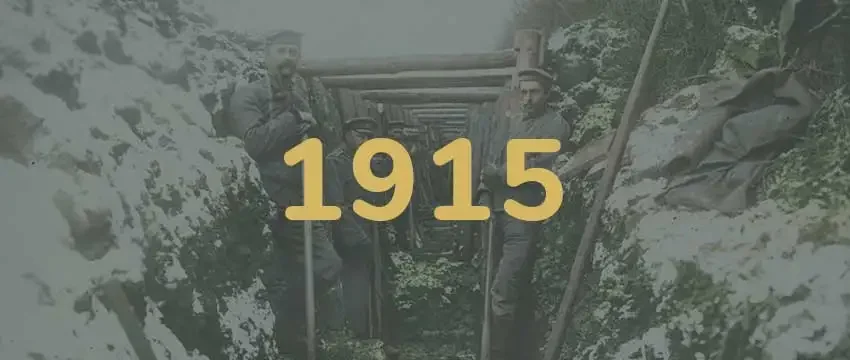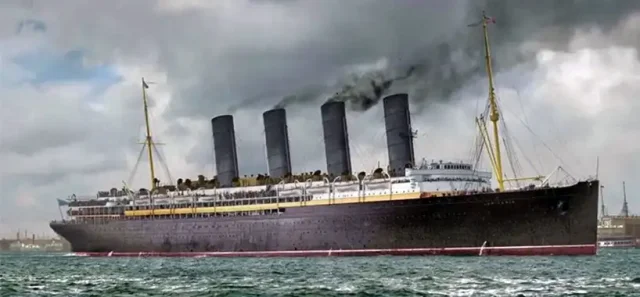- Military History
- Conflicts & Wars
- World War I
- History & Theaters WWI
- World War I Western Front (1915) - Part 2

World War I Western Front (1915) - Part 2 Events that took place in the second year of WWI
The dramatic sinking of the Lusitania by a german submarine marked the second year of World War I. Most notable were also the battles at Neuve-Chapelle, of Woëvre, the second battle of Ypres, Vimy Ridge, renewed fighting in Champagne and Artois and finally the battle of Loos.
Index of content
An Innovative Approach at Neuve-Chapelle
On March 10, 1915, British general Sir Douglas Haig (1861–1928) tried an alternative approach to battle at Neuve-Chapelle, just below the Lys River in northwestern France. He began an assault by his First Army with an intensive 35-minute “artillery preparation,” using artillery to bombard a narrow front of 2,000 yards. This was followed by an infantry advance. Haig’s idea was to concentrate combat, hoping to break through the deadlock to disrupt German supply and communication lines.
At first, the operation went well, but then it fell apart because of poor execution, communication, and coordination. Haig felt he had come close to achieving a breakthrough. Analyzing what had gone wrong, Haig and the other Allied commanders decided that the artillery preparation had been insufficient. In the future, they decided, long barrages would precede offensives; in many places along the western front, World War I now became a duel between artillery batteries. The result would be battles that were ever more destructive but no more productive. Extended artillery bombardment sacrificed the element of surprise and so chewed up battlefields that attackers had great trouble advancing.
The Battle of Woëvre
The western front was not a straight line running north to south but included bulges of German strength projecting into Allied territory. The two most prominent of these “salients” were the Noyon salient and the Saint-Mihiel salient. The latter, between Verdun and Toul, would loom throughout the war as an inviting target for Allied offensives. From April 6 to April 15, French units repeatedly attacked the northern face of the Saint-Mihiel salient at the Battle of Woëvre. The Germans held fast, and the French withdrew with heavy losses.
The Second Battle of Ypres
Far to the north of Woëvre, the Allies prepared for a second attempt at an offensive against Ypres, Belgium. While preparation was under way, the Germans launched the first poison-gas attack on the western front, on April 22, 1915.
Five thousand Allied troops died, and panic was general along a six kilometer (four-mile) stretch of front. Fortunately for the Allies, however, the Germans failed to exploit the breach in the lines, and both sides soon resumed their original positions after a series of attacks and counterattacks. Like the other western-front battles after August 1914, the Second Battle of Ypres ended in a continued deadlock. German casualties numbered 35,000 killed and wounded; those of the British, 60,000; of the French, 10,000.
The Lusitania is Sunk
Beginning early in the war, the German navy pursued a policy of unrestricted submarine warfare, meaning that German U-boats could attack all Allied shipping, military and civilian, without first surfacing to give warning. On May 7, 1915, a U-boat torpedoed and sank the British liner Lusitania, with the loss of 1,198 lives, including 124 Americans.
Amid great public outrage, President Wilson issued a stern note of diplomatic protest to the Germans. Despite the American complaint, in August, a U-boat sank the Arabic, again with loss of American lives. But Kaiser Wilhelm II, fearing that such action would provoke U.S. entry into the war, ordered an end to unrestricted submarine warfare.
The Battle of Vimy Ridge
Southeast of Ypres, in northwestern France, the British staged an offensive in May by which they gained little before they were stopped at Festubert, southwest of Neuve Chapelle on May 26.
To the south of the British position, the French launched a vigorous offensive against Vimy Ridge, seeking to push the Germans off this commanding piece of high ground. This battle, near the French town of Souchez, ground on from May 16 to the end of June, at which point the Allies broke off the attack, having achieved nothing. Both sides refrained from mounting new offensives throughout the rest of the summer of 1915.
Renewed Fighting in Champagne and Artois
Joffre renewed the Allied offensive in the Champagne, sustaining the campaign from September 25 to November 6, 1915. The Second Battle of Champagne resulted in 75,000 German casualties and 100,000 men wounded or killed among the French. From September 25 to October 30, the Third Battle of Artois sought again to dislodge the Germans from Vimy Ridge. Minor territorial gains came at the cost of another 100,000 French casualties.
The Battle of Loos
North of the French at Vimy, the British attacked Loos during September 25–October 14, making small gains in territory but at the cost of 60,000 casualties. Following this, the British high command replaced Sir John French with Sir Douglas Haig, who would spend their lives even more prodigally than French had.
- {{#owner}}
- {{#url}} {{#avatarSrc}}
{{name}} {{/url}} {{^url}} {{#avatar}} {{& avatar}} {{/avatar}} {{name}} {{/url}} - {{/owner}} {{#created}}
- {{created}} {{/created}}
























